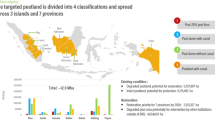Abstract
In response to protection needs in class I wilderness areas, forest land managers of the USDA Forest Service must provide input to regulatory agencies regarding air pollutant impacts on air quality-related values. Regional workshops have been convened for land managers and scientists to discuss the aspects and extent of wilderness protection needs. Previous experience with a national workshop indicated that a document summarizing workshop discussions will have little operational utility. An alternative is to create a knowledge-based analytical system, in addition to the document, to aid land managers in assessing effects of air pollutants on wilderness. Knowledge-based methods were used to design and conduct regional workshops in the western United States. Extracting knowledge from a large number of workshop participants required careful planning of workshop discussions. Knowledge elicitation methods helped with this task. This knowledge-based approach appears to be effective for focusing group discussions and collecting knowledge from large groups of specialists.
Similar content being viewed by others
Literature Cited
Benfer, R. A., and L. Furbee. 1989. Knowledge acquisition in the Peruvian Andes.AI Expert 4(11):22–29.
Boose, J. H. 1986. Experitise transfer for expert system design. Elsevier, New York, 312 pp.
Christiano, J., and M. Scruggs. 1985. Permit application guidance for new air polution sources. Natural Resources Report Series No. 85-2. USDI National Park Service, Air Quality Division, Denver, Colorado.
Crawford, C. C., and J. W. Demidovich, 1981. Think tank technology for system management.Journal of System Management November 1981:22–25.
Dalkey, N. C., and O. Helmer. 1963. An experimental application of the Delphi method to the use of experts.Management Science 9(3):458–467.
de Steiguer, J. E., J. M. Pye, and C. S. Love. 1990. Air pollution damage to U.S. forests.Journal of Forestry 88(8):17–22.
Duriscoe, D. M., and K. W. Stolte. 1989. Photochemical oxidant injury to ponderosa pine (Pinus ponderosa Laws.) and Jeffrey pine (Pinus jeffreyi Grev. and Balf.) in the national parks of the Sierra Nevada of California. Pages 261–278in R. K. Olson and A. S. Lefohn (eds.), Effects of air pollution on western forests. Air and Waste Management Association, Pittsburgh, Pennsylvania.
Fox, D. G., A. M. Bartuska, J. G. Byrne, and others. 1989. A screening procedure to evaluate air pollution effects on class I wilderness areas. Gen. Tech. rep. RM-168. USDA Forest Service, Rocky Mountain Forest and Range Experiment Station, Fort Collins, Colorado, 36 pp.
Hogsett, W. E., D. T. Tingey, C. Hendricks, and D. Rossi. 1989. Sensitivity of western conifers to SO2 and seasonal interaction of acid fog and ozone. Pages 469–491in R. K. Olson and A. S. Lefohn (eds.), Effects of air pollution on western forests. Air and Waste Management Association, Pittsburgh, Pennsylvania.
Miller, P. R., G. J. Longbotham, and C. R. Longbotham. 1983. Sensitivity of selected western conifers to ozone.Plant Disease 67:1113–1115.
Miller, P. R., J. R. McBride, S. L. Schilling, and A. P. Gomez. 1989. Trend of ozone damage to conifer forests between 1974 and 1988 in the San Bernardino Mountains of southern California. Pages 309–323in R. K. Olson and A. S. Lefohn (eds.), Effects of air pollution on western forests. Air and Waste Management Association, Pittsburgh, Pennsylvania.
Mittal, S., and C. L. Dym. 1985. Knowledge acquisition from multiple experts.AI Magazine 6(2):32–36.
Nash, T. H., and V. Wirth (eds.). 1988. Lichens, bryophytes, and air quality. J Cramer, Berlin, Germany, 297 pp.
Olson, J. R., and H. H. Rueter. 1987. Extracting expertise from experts: Methods for knowledge acquisition.Expert Systems 4(3):152–168.
Peterson, D. L., D. L. Schmoldt, R. Doty, and T. H. Nash. 1991a. A regional screening guide for protecting air quality in class I wilderness: Pacific Southwest Region. USDA Forest Service Gen. Tech. Rep. Pacific Southwest Research Station, Berkeley, California (in preparation).
Peterson, D. L., D. L. Schmoldt, and J. L. Peterson. 1991b. A regional screening guide for protecting air quality in class I wilderness: Pacific Northwest Region. USDA Forest Service Gen. Tech. Rep. Pacific Northwest Forest and Range Experiment Station, Portland, Oregon (in preparation).
Pronos, J., D. R. Vogler, and R. S. Smith. 1978. An evaluation of ozone injury to pines in the southern Sierra Nevada. Forest Pest Management Report 78-1. USDA Forest Service Pacific Southwest Region, San Francisco, California.
Pye, J. M., J. E. de Steiguer, and C. Love. 1989. Expert opinion survey on the impacts of air pollutants on forests of the USA. Pages 355–360in J. B. Bucher and I. Bucher-Wallin (eds.), air pollution and forest decline, Proceedings of 14th international meeting for specialists in air pollution effects on forest ecosystems (IUFRO Project Group P2.05). Eidgenossische Anstalt fur das forstliche Versuchswesen. CH-8903 Birmensdorf, Switzerland.
Schmoldt, D. L. 1987. Evaluation of an expert system approach to forest pest management of red pine (Pinus resinosa). PhD dissertation. University Microfilms International 87-08, 112. 225 pp.
Schmoldt, D. L., and W. G. Bradshaw. 1988. A cumulative Delphi approach toknowledge acquisition. Pages 149–162in Y. Wilks (ed.), Proceedings of the third annual. Rocky Mountain conference on artificial intelligence. Rocky Mountain Society for Artificial Intelligence, Denver, Colorado.
Schmoldt, D. L., and H. M. Rauscher. 1991. Building knowledge-based systems for natural resource management. Chapman & Hall, New York (in press).
Starfield, A. M., and A. L. Bleloch. 1986. Building models for conservation and wildlife management. Macmillan, New York, 253 pp.
Van de Ven, A., and A. Delbecq. 1971. Nominal vs. interacting group processes for committee decision making effectiveness.Academy of Management Journal 14:203–212.
von Winterfeldt, D., and W. Edwards. 1986. Decision analysis and behavioral research. Cambridge University Press, Cambridge, UK, 604 pp.
Zadeh, L. A. 1965. Fuzzy sets.Information and Control 8:338–353.
Author information
Authors and Affiliations
Rights and permissions
About this article
Cite this article
Schmoldt, D.L., Peterson, D.L. Applying knowledge-based methods to design and implement an air quality workshop. Environmental Management 15, 623–634 (1991). https://doi.org/10.1007/BF02589622
Issue Date:
DOI: https://doi.org/10.1007/BF02589622




